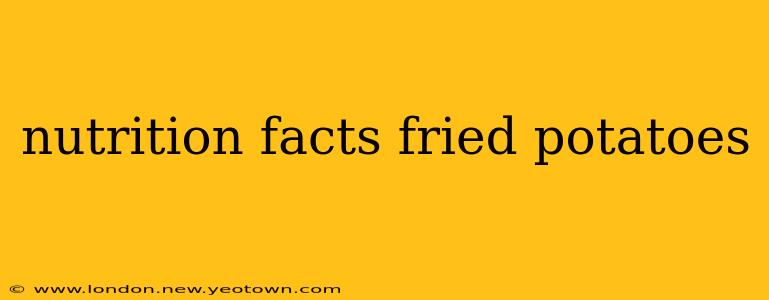Let's be honest, the irresistible aroma of fried potatoes, whether they're crispy fries, golden wedges, or fluffy hash browns, is enough to make anyone's mouth water. But beyond the deliciousness, what's the nutritional story behind these popular treats? This deep dive explores the nutritional facts of fried potatoes, addressing common questions and helping you make informed choices about your consumption.
How many calories are in fried potatoes?
This is a question with a highly variable answer! The calorie count in fried potatoes depends heavily on several factors: the type of potato, the cooking method (oil type and amount used), the size of the serving, and any added seasonings. A small serving of french fries might contain around 200-300 calories, while a larger portion or a serving of loaded fries could easily exceed 500 calories. Think of it this way: the more potato, the more oil, and the more additions (cheese, bacon, etc.), the higher the calorie count.
Are fried potatoes healthy?
Let's cut to the chase: fried potatoes, in general, aren't considered a health food. The frying process significantly alters the nutritional profile of the potato. While potatoes themselves offer some nutrients like potassium and vitamin C, deep-frying negates many of these benefits. The high fat content from the cooking oil dramatically increases the calorie density, and the process can also create acrylamide, a compound formed when starchy foods are fried or baked at high temperatures. While the long-term health effects of acrylamide are still under investigation, it's generally advisable to limit your intake of fried foods.
What are the nutritional values of fried potatoes?
The nutritional breakdown of fried potatoes varies widely based on the factors mentioned earlier. However, a general idea is that a serving will be high in calories and fat, with a moderate amount of carbohydrates. They typically offer minimal amounts of vitamins and minerals compared to their unfried counterparts. The type of oil used in frying also significantly impacts the nutritional profile, with some oils offering more beneficial fatty acids than others. For instance, olive oil is generally healthier than partially hydrogenated oils.
Are there healthier ways to cook potatoes?
Absolutely! Frying isn't the only way to enjoy potatoes. Baking, roasting, boiling, and steaming are all much healthier alternatives. These methods preserve more of the potato's natural nutrients and significantly reduce the fat and calorie content. Consider experimenting with herbs and spices instead of relying on salt and oil to enhance the flavor.
How can I reduce the calories in fried potatoes?
If you're craving fried potatoes, there are a few strategies to reduce the caloric impact. Opt for smaller portions, choose fries that appear less greasy, and be mindful of extra toppings. Air frying is a healthier alternative to deep frying, reducing the amount of oil needed while still achieving a crispy texture. Even better, try making your own baked fries or wedges at home; you can control the oil quantity and added ingredients.
What are the health risks associated with eating too many fried potatoes?
Consuming excessive amounts of fried potatoes can contribute to weight gain, heart disease, and type 2 diabetes due to their high calorie and saturated fat content. The high sodium content, often from added salt, can also increase blood pressure. The acrylamide content, as previously mentioned, is another potential health concern that warrants moderation in fried food consumption.
Ultimately, while the occasional indulgence in fried potatoes is unlikely to cause significant harm, regular and excessive consumption should be approached with caution. Prioritizing healthier cooking methods and mindful portion control will go a long way in maintaining a balanced and healthy diet.

